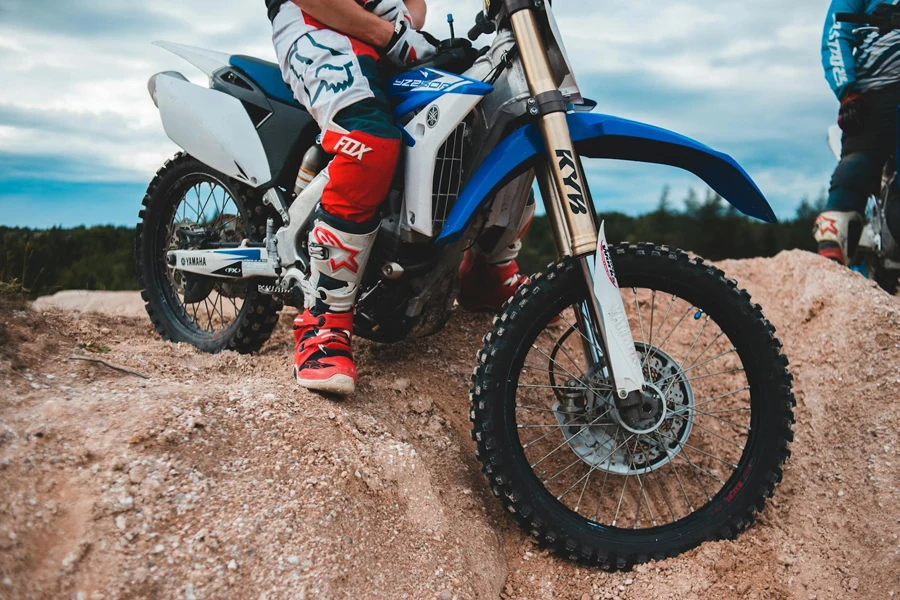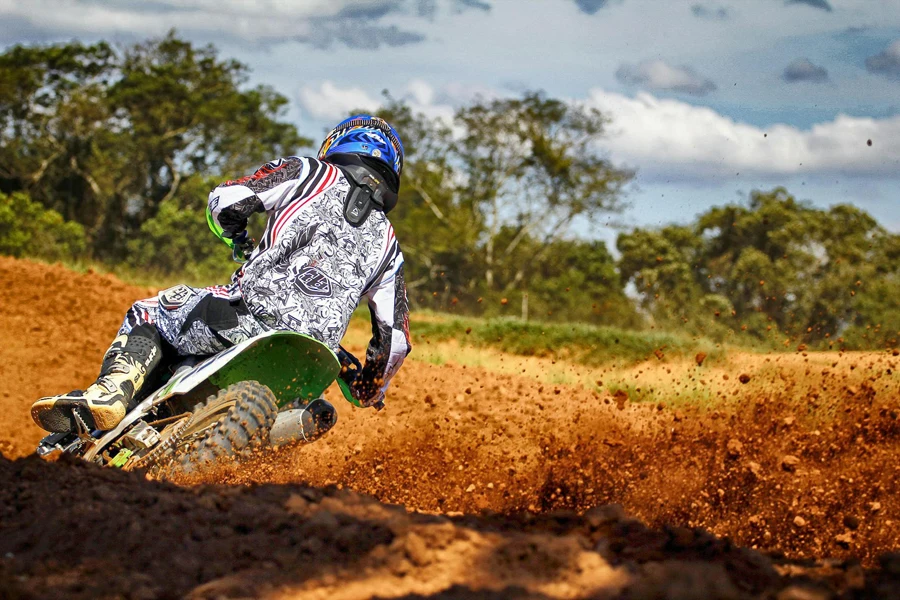Table of Contents
● Introduction
● Market overview
● Key technology and design innovations
● Top-selling models driving market trends
● Conclusion
Introduction
The off-road motorcycle market continues to thrive as advancements in technology meet the demands of diverse terrains and adventurous riders. With significant growth driven by innovative engineering and design, these motorcycles have become more capable and versatile, appealing to a wide range of enthusiasts. From lightweight models designed for agility to robust machines built for endurance, the sector showcases a remarkable fusion of performance and resilience. As manufacturers push the boundaries with new materials and smarter safety features, the appeal of off-road biking broadens, inviting riders to explore the limits of both their machines and their own capabilities. This evolution marks a vibrant period in the industry, characterized by rapid technological progress and increasing consumer engagement.

Market overview
The off-road motorcycle market is on a robust growth trajectory, projected to reach a volume of approximately $9.69 billion by 2028, which represents a steady compound annual growth rate (CAGR) of 3.33% from 2024 to 2028, according to Statista. This expansion is underpinned by an expected surge in unit sales, projected to escalate to 1.82 million motorcycles by the end of the forecast period. Such figures demonstrate a burgeoning global interest in off-road motorcycling, fueled by consumers’ increasing enthusiasm for recreational and adventure activities. Economic stability in key markets plays a pivotal role in this upward trend, enabling consumers to invest more in leisure pursuits that include off-road riding.
In response to evolving market dynamics, manufacturers are innovating with a focus on sustainability and performance to meet stringent environmental regulations and shifting consumer preferences. The transition towards electric off-road motorcycles is particularly noteworthy, marking a significant turn towards environmental consciousness. Investments in this area are aimed at enhancing fuel efficiency and reducing emissions, with the average price of off-road motorcycles projected to be around $5.27k in 2024, according to Statista. This shift is underlined by the growing consumer demand for high-performance, durable motorcycles that are equipped with advanced safety features, which is also driving market growth. Furthermore, the popularity of adventure tourism and competitive off-road racing continues to influence market trends, contributing to a projected increase in sales volume by 1.82 million units by 2028. These market dynamics underscore not only robust growth but also the industry’s agile adaptation to both economic and environmental changes, demonstrating a dynamic response to global consumer behavior trends and economic conditions.

Key technology and design innovations
Advanced suspension systems
Suspension technology plays a critical role in off-road motorcycle performance, particularly in handling rough and uneven terrains. Innovations in this area have led to the development of advanced systems featuring long-travel suspension, which provides enhanced shock absorption and stability. These systems often include adjustable damping and preload settings, allowing riders to customize the suspension response based on terrain conditions and personal preferences. For example, inverted telescopic forks with cartridge dampers and multi-link rear suspension setups with piggyback reservoirs are common, offering superior rigidity and precision. Progressive damping systems, such as dual-stage valving, adjust the damping force in response to the magnitude of impacts, providing a smoother ride over both small bumps and large obstacles. Additionally, advanced materials like anodized aluminum and magnesium are used in suspension components to reduce weight and increase durability. These technical improvements not only enhance performance but also contribute to rider comfort and safety.
Advanced frame and chassis design
Modern off-road motorcycles benefit from significant advancements in frame and chassis design, which enhance durability and handling performance. High-strength, lightweight materials such as aluminum alloys and composite materials are used in the construction of frames and subframes. These materials provide a robust yet lightweight structure, reducing the overall weight of the motorcycle while maintaining strength and rigidity. The design of the chassis is optimized for off-road use, with features such as reinforced welds and strategic gusseting to withstand the stresses of rough terrain riding. Additionally, the geometry of the frame is carefully engineered to balance stability and agility. A shorter wheelbase improves maneuverability, while a longer swingarm enhances traction and stability on uneven surfaces. These design elements work together to provide a more responsive and durable motorcycle capable of handling the rigors of off-road adventures.
Enhanced engine performance
Engine technology has seen substantial advancements, focusing on increasing power output and efficiency while maintaining reliability. Modern off-road motorcycles are equipped with engines ranging from 250cc to 1300cc, providing a wide spectrum of power options to suit different riding styles and terrains. Innovations such as dual overhead camshafts (DOHC), liquid cooling, and electronic fuel injection systems have become standard. These features optimize combustion efficiency, delivering more power per unit of fuel. For instance, a 450cc engine can produce over 50 horsepower, allowing for rapid acceleration and high top speeds. Advanced engine management systems adjust fuel delivery and ignition timing based on real-time conditions, enhancing performance and reducing emissions. Additionally, lightweight materials in engine construction reduce overall mass, contributing to better handling and fuel efficiency.
Electronic aids
The integration of electronic aids has transformed the off-road riding experience, providing enhanced safety and performance. Anti-lock Braking Systems (ABS) employ wheel speed sensors and hydraulic modulators to monitor wheel rotation and modulate brake pressure, preventing wheel lockup during hard braking, especially on low-traction surfaces. Traction control systems utilize inertial measurement units (IMUs) and throttle position sensors to detect and correct wheel spin by adjusting throttle input and ignition timing, ensuring optimal traction and stability. Ride modes are managed by sophisticated Electronic Control Units (ECUs) that adjust engine mapping, throttle response, and intervention levels of traction control and ABS to suit different riding conditions. Modern motorcycles are also equipped with TFT (Thin Film Transistor) LCD displays that provide high-resolution, real-time data on engine performance, navigation, and riding metrics. These displays often include Bluetooth connectivity for seamless integration with smartphones, enabling riders to access calls, messages, and multimedia directly from the motorcycle’s dashboard. Additional electronic aids such as quick-shifters and auto-blippers enable seamless, clutchless gear changes, enhancing the riding experience by providing smoother and faster shifts. Hill start assist, cornering ABS, and lean-sensitive traction control further enhance safety and control, adapting to the specific dynamics of off-road riding.
Ergonomic designs and fuel efficiency
Ergonomic design improvements have focused on enhancing rider comfort and control, crucial for long off-road journeys. Adjustable components such as seats, handlebars, and footpegs allow riders to customize their riding position for optimal comfort and control. For example, seats with adjustable height and padding can accommodate different rider sizes and preferences, reducing fatigue during extended rides. Handlebars that can be adjusted for reach and angle provide better leverage and comfort. Footpegs with multiple mounting positions allow for a tailored fit that enhances control and reduces strain on the legs. Innovations aimed at increasing fuel efficiency are also critical for off-road motorcycles, which often need to cover long distances between fuel stops. Advanced fuel injection systems and optimized combustion processes have significantly improved fuel economy. For instance, modern 450cc engines can achieve fuel consumption rates as low as 40 miles per gallon (mpg), while larger 1200cc engines can reach 35 mpg, depending on riding conditions. Lightweight materials and aerodynamic designs further enhance fuel efficiency, making these motorcycles more practical for extended adventures.

Top-selling models driving market trends
Lightweight segment
The rising popularity of lightweight off-road motorcycles underscores a market trend toward agility and manageability. These models are particularly appealing due to their ease of handling, making them suitable for both novice riders and seasoned adventurers seeking a bike that responds swiftly on challenging terrains. The lightweight segment benefits significantly from advancements in material technology, utilizing high-strength, low-weight composites that reduce overall mass without sacrificing durability. This reduction in weight enhances the motorcycle’s responsiveness and maneuverability, allowing for sharper turns and easier control, which is crucial in avoiding obstacles and navigating tight trails. Moreover, the lighter weight reduces rider fatigue, enabling longer rides with less physical strain, thereby increasing the appeal of lightweight models for extended off-road adventures.
Mid-weight category
Mid-weight off-road motorcycles represent a sweet spot in the market, offering a balance between robust performance and rider comfort. These bikes are designed to handle a variety of terrains, making them suitable for riders who enjoy both trail riding and longer expeditions. Typically equipped with engines that provide a good mix of power and efficiency, mid-weight models offer enough thrust for challenging terrains while maintaining reasonable fuel consumption. Comfort is also a key feature, with manufacturers incorporating ergonomic designs that support proper riding posture, reducing stress on the rider’s body during long journeys. Adjustable suspensions and padded seats further enhance the riding experience, making these bikes versatile enough for both rough off-road conditions and smoother, long-distance travel, thus meeting the demands of a diverse rider demographic.
Heavy-duty focus
Heavy-duty off-road motorcycles are built for the most extreme riding conditions, designed to push the boundaries of what is possible in off-road capability. These models are typically equipped with larger, more powerful engines and advanced features like dynamic traction control and sophisticated suspension systems that can handle severe bumps and obstacles. The robust construction of heavy-duty bikes means they are better suited to withstand the harsh environments of off-road riding, from rocky paths to muddy trails. Additionally, these motorcycles often feature enhanced safety elements such as reinforced frames and superior braking systems, providing peace of mind in challenging conditions. For riders looking to conquer the toughest terrains and undertake the most arduous adventures, heavy-duty motorcycles offer the performance and durability needed to tackle such demanding tasks.

Market dynamics and trends
Each segment within the off-road motorcycle market caters to specific rider needs and preferences, reflecting a broad spectrum of demand and a dynamic approach to motorcycle design. As the market evolves, manufacturers continue to innovate, focusing on integrating the latest technology across all segments to enhance the overall rider experience. The ongoing development and refinement of off-road motorcycles ensure that whether riders choose lightweight, mid-weight, or heavy-duty models, they benefit from advancements that make riding safer, more enjoyable, and more accessible. This adaptability not only drives current market trends but also positions the off-road motorcycle industry for future growth and diversification, responding adeptly to the changing landscapes of consumer demand and technological possibilities.
Conclusion
The ongoing advancements in technology and design have been pivotal in enhancing the appeal and capabilities of off-road motorcycles. Innovations in engine efficiency, lightweight materials, and advanced suspension systems have not only improved performance but also made these motorcycles more accessible to a broader audience. These enhancements cater to the increasing consumer demand for vehicles that can handle diverse terrains while providing safety and comfort. As a result, the popularity of off-road motorcycles continues to grow, driven by enthusiasts who seek adventure and outdoor activities. The industry’s ability to adapt to changing market conditions, such as environmental regulations and evolving consumer preferences, demonstrates its resilience and foresight. By continually integrating cutting-edge technologies and responding to the needs of modern riders, the off-road motorcycle industry is well-positioned to thrive. The growing interest in outdoor and adventure activities further fuels this sector, promising a dynamic future for the development of motorcycles that push the limits of exploration and excitement.




